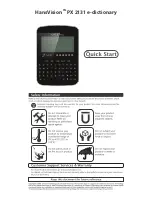
Sound Parameters – Filter
87
Waldorf Q User’s Manual
Filter Panel Controls
The most commonly used controls of the filters can be found on the front panel.
Cutoff
0…127
Controls the cutoff frequency for the low pass and high pass filter types, the center frequency for the
band pass and notch filter types and the delay length of the comb filter types.
•
When a low pass is selected via the
Type
parameter, all frequencies above the cutoff
frequency are damped.
•
When a high pass type is selected, all frequencies below the cutoff frequency are damped.
•
When a band pass type is selected, only frequencies near the cutoff setting will be passed
through.
•
When a notch type is selected, the frequencies near the cutoff frequency are damped.
•
When a comb type is selected, the frequencies near the cutoff frequency are emphasized
(comb+) or attenuated (comb-).
You can bring more movement into the sound by modulating the cutoff frequency via the LFOs, the
envelopes or the
Keytrack
parameter. At a value of
64
and a
Resonance
value of
114
, the filter
oscillates with 440Hz, which is equal to A3 (the Comb+ type oscillates one octave higher). Tuning is
scaled in semitone steps. When
Keytrack
is set to
+100%
, the filter can be played in a tempered
scale.
Resonance
0…127
Controls the emphasis of the frequencies around the cutoff point. Use lower values in the range of
0…80
to give more brilliance to the sound. At higher values of
80…113
the sound gets the typical
filter character with a strong boost around the cutoff frequency. When the setting is raised to values
above
113
, the filter starts to self-oscillate, generating a pure sine wave. This feature can be used to
create analog-style effects and percussion-like electronic toms, kicks, zaps etc.
Keytrack
-200%…+197%
Determines how much the cutoff frequency depends on the MIDI note number. The reference note
for Keytrack is E3, note number 64. For positive settings, the cutoff frequency rises on notes above the
reference note, for negative settings the cutoff frequency falls up to higher notes and vice versa. A
setting of
+100%
corresponds to a 1:1 scale, so e.g. when an octave is played on the keyboard the
cutoff frequency changes for the same amount. If you want to play the filter in a tempered scale, e.g.
for a solo sound with self-oscillation, set the value to
+100%
. On most bass sounds lower settings in
the range
+50…+75%
are optimal to keep the sound smooth at higher notes.
Type
see chapter “Filter Types” on page 90
Selects the filter type. Further information on the different filter types is given at the end of this chapter
on page 90.
Env
-64…+63
Determines the amount of influence the filter envelope has on the cutoff frequency. For positive
settings, the filter cutoff frequency is increased by the modulation of the envelope, for negative
settings, the cutoff frequency is decreased. Use this parameter to change the timbre of the sound over
Содержание Q Rack
Страница 1: ...User s Manual Q Keyboard Q Rack ...
Страница 170: ...Appendix MIDI Implementation Chart Waldorf Q User s Manual 170 ...
Страница 172: ......
Страница 173: ......
















































